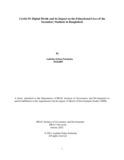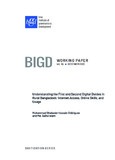Covid-19: digital divide and its impact on the educational lives of the secondary students in Bangladesh

View/Open
Date
2022-01Publisher
Brac UniversityAuthor
Purbasha, Audrika EshnaMetadata
Show full item recordAbstract
Ever since the widespread use of ICT, the digital divide has been prominent across different socioeconomic groups and gender in Bangladesh (Zahan, 2021). Moreover, the digital platform being the only medium to study during the school closure period, many students have been found to have a hampered educational life. A recent study jointly conducted by the PPRC and BIGD found that 19 percent of primary students and 25 percent of secondary students are at learning loss risk (Rahman & Matin, 2021). Nevertheless, several studies have been conducted which targeted to understand the child marriage and involvement in paid work as contributing factors to impacting educational lives of secondary students including learning loss risk but not much light had been shed on the in-depth investigation of the relation of the digital divide and the educational lives of the secondary students. Therefore, the purpose of this study is to explore how DAD (digital access divide) and DCD (digital capability divide) are impacting the educational lives of secondary school students during the school closure phase of the Covid-19 pandemic. Using a qualitative case study method this research conducted 10 in-depth interviews (IDI) with the variation of rural-urban and male-female secondary school students from Mymensingh, Sylhet, and Dhaka divisions. Two KII were also conducted where the Key Informants were from academic and government policy levels. The initial observations suggest that most of the secondary school students of both rural and urban areas do not have access to digital devices (smartphones, computers, etc.) to be used for educational purposes. Besides, female students are more comfortable with non-interactive (TV, radio) platforms while male students prefer interactive platforms. Another observation suggested that students are now finding it difficult to understand their lessons after reopening of the school. Figuring out any existing gap would thereby aid in future policy implications and appropriate interventions.
Keywords
Digital divide; Digital access; Digital capability; Educational lives; Secondary students; Digital deviceLC Subject Headings
COVID-19 (Disease); Developing countries -- Economic policy -- 21st century.; Education, SecondaryDescription
This thesis is submitted in partial fulfillment of the requirements for the degree of Masters of Development Studies, 2022.Department
BRAC Institute of Governance and Development, Brac UniversityType
ThesisCollections
Related items
Showing items related by title, author, creator and subject.
-
Understanding the First and Second Digital Divides in Rural Bangladesh
Siddiquee, Muhammad Shahadat Hossain; Islam, Md. Saiful (BRAC Institute of Governance and Development (BIGD), 2020-12)Differences in individuals’ access to internet infrastructure refer to the first-level digital divide, whereas differences in an individual’s online skills and internet usage refer to the second-level digital divide. ... -
Most rural households lack digital access
The Daily Star (The Daily Star, 2021-09-15) -
The trend of wearing contact lenses now-a-days Coolense: A famous contact lenses brand
Abanty, Rifat Tashfiha (BRAC University, 2017-08-17)Cookie Jar is one of the leading Digital Marketing Agency in Bangladesh. Cookie Jar has established a strong foothold in the digital media branding scene of Bangladesh. The have worked with Emami, The Daily Star, MobiMedia, ...



